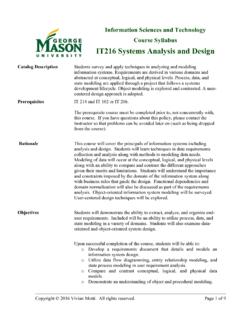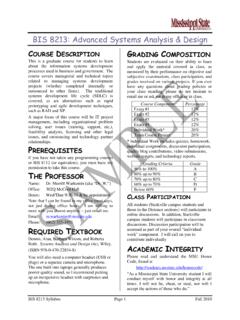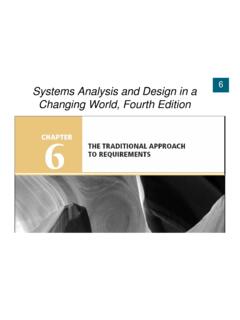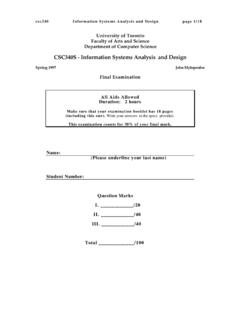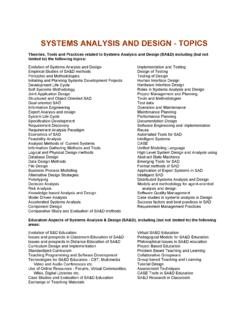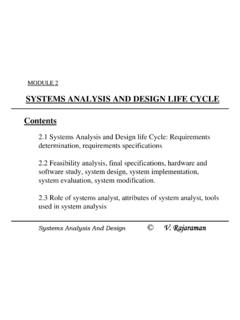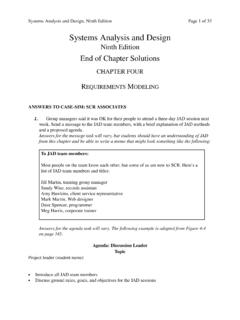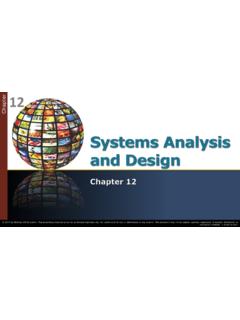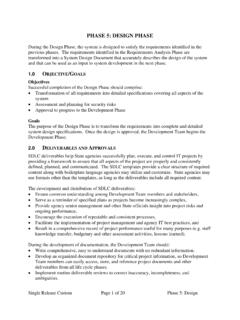Transcription of About the Tutorial - Current Affairs 2018, Apache …
1 0 Systems analysis and design i About the Tutorial Systems analysis and design is an active field in which analysts repetitively learn new approaches and different techniques for building the system more effectively and efficiently. The primary objective of systems analysis and design is to improve organizational systems. This Tutorial provides a basic understanding of system characteristics, system design , and its development processes. It is a good introductory guide that provides an overview of all the concepts necessary to build a system . Audience This Tutorial will help budding software professionals to understand how a system is designed in a systematic and phased manner, starting from requirement analysis to system implementation and maintenance.
2 Prerequisites This Tutorial is designed for absolute beginners and hence there are no prerequisites as such, however it is assumed that the reader is familiar with the fundamentals of computers. Disclaimer & Copyright Copyright 2018 by tutorials Point (I) Pvt. Ltd. All the content and graphics published in this e-book are the property of tutorials Point (I) Pvt. Ltd. The user of this e-book is prohibited to reuse, retain, copy, distribute, or republish any contents or a part of contents of this e-book in any manner without written consent of the publisher. We strive to update the contents of our website and tutorials as timely and as precisely as possible, however, the contents may contain inaccuracies or errors. tutorials Point (I) Pvt. Ltd. provides no guarantee regarding the accuracy, timeliness, or completeness of our website or its contents including this Tutorial .
3 If you discover any errors on our website or in this Tutorial , please notify us at Systems analysis and design ii Table of Contents About the Tutorial .. i Audience .. i Prerequisites .. i Disclaimer & Copyright .. i Table of Contents .. ii 1. SYSTEMS analysis AND design 1 Systems analysis .. 1 Systems design .. 1 What is a system ? .. 1 Properties of a system .. 2 Elements of a system .. 3 Types of Systems .. 4 Systems 6 Categories of Information .. 7 2. SYSTEMS analysis AND design system DEVELOPMENT LIFE CYCLE .. 8 Phases of SDLC .. 8 Life Cycle of system analysis and design .. 11 Role of system Analyst .. 11 Attributes of a Systems Analyst .. 12 3. SYSTEMS analysis AND design system PLANNING .. 14 What is Requirements Determination? .. 14 Major Activities in requirement Determination .. 14 Information Gathering Techniques.
4 14 Feasibility Study .. 17 Systems analysis and design iii Steps Involved in Feasibility analysis .. 18 Types of 18 4. SYSTEMS analysis AND design STRUCTURED analysis .. 20 What is Structured analysis ? .. 20 Structured analysis Tools .. 20 Data Flow Diagrams (DFD) or Bubble Chart .. 21 Data Dictionary .. 23 Decision Trees .. 23 Decision Tables .. 24 Structured English .. 25 Pseudocode .. 26 Guidelines for Selecting Appropriate Tools .. 26 5. SYSTEMS analysis AND design system design .. 28 Inputs to system design .. 28 Outputs for system design .. 29 Types of system design .. 29 File Organization .. 31 File Access .. 32 Documentation Control .. 33 Types of Documentations .. 34 User Documentation .. 34 system Documentation .. 35 6. SYSTEMS analysis AND design design STRATEGIES .. 36 Top-Down Strategy.
5 36 Bottom-Up Strategy .. 36 Systems analysis and design iv Structured design .. 37 Factors Affecting system Complexity .. 39 7. SYSTEMS analysis AND design INPUT / OUTPUT & FORMS 42 Input design .. 42 Output design .. 43 Forms design .. 44 8. SYSTEMS analysis AND design TESTING AND QUALITY ASSURANCE .. 46 Testing .. 46 Types of Testing .. 47 Rules for system Testing .. 48 Quality Assurance .. 48 9. SYSTEMS analysis AND design system IMPLEMENTATION AND MAINTENANCE .. 50 Training .. 50 Training Methods .. 51 Conversion .. 51 system Maintenance / Enhancement .. 54 10. SYSTEMS analysis AND design system SECURITY AND AUDIT .. 55 system Audit .. 55 Audit of Computer system Usage .. 55 Audit Trial .. 55 Audit Methods .. 55 Audit Considerations .. 56 Security .. 56 Control Measures .. 56 Risk analysis .
6 57 Systems analysis and design v 11. SYSTEMS analysis AND design OBJECT-ORIENTED APPROACH .. 59 Elements of Object-Oriented system .. 59 Features of Object-Oriented system .. 60 Structured Approach Vs. Object-Oriented Approach .. 61 Unified Modeling Language (UML) .. 61 Operations Performed on Objects .. 63 Uses of UML .. 63 Static Models .. 63 Dynamic Models .. 63 Object Oriented system Development Life Cycle .. 64 Object Oriented Systems Development Activities .. 64 Systems analysis and design 6 Systems development is systematic process which includes phases such as planning, analysis , design , deployment, and maintenance. Here, in this Tutorial , we will primarily focus on: Systems analysis Systems design Systems analysis It is a process of collecting and interpreting facts, identifying the problems, and decomposition of a system into its components.
7 system analysis is conducted for the purpose of studying a system or its parts in order to identify its objectives. It is a problem solving technique that improves the system and ensures that all the components of the system work efficiently to accomplish their purpose. analysis specifies what the system should do. Systems design It is a process of planning a new business system or replacing an existing system by defining its components or modules to satisfy the specific requirements. Before planning, you need to understand the old system thoroughly and determine how computers can best be used in order to operate efficiently. system design focuses on how to accomplish the objective of the system . system analysis and design (SAD) mainly focuses on: Systems Processes Technology What is a system ?
8 The word system is derived from Greek word Systema, which means an organized relationship between any set of components to achieve some common cause or objective. A system is an orderly grouping of interdependent components linked together according to a plan to achieve a specific goal. Constraints of a system A system must have three basic constraints: 1. A system must have some structure and behavior which is designed to achieve a predefined objective. 1. Systems analysis and design Overview Systems analysis and design 7 2. Interconnectivity and interdependence must exist among the system components. 3. The objectives of the organization have a higher priority than the objectives of its subsystems. For example, traffic management system , payroll system , automatic library system , human resources information system .
9 Properties of a system A system has the following properties: Organization Organization implies structure and order. It is the arrangement of components that helps to achieve predetermined objectives. Interaction It is defined by the manner in which the components operate with each other. For example, in an organization, purchasing department must interact with production department and payroll with personnel department. Interdependence Interdependence means how the components of a system depend on one another. For proper functioning, the components are coordinated and linked together according to a specified plan. The output of one subsystem is the required by other subsystem as input. Integration Integration is concerned with how a system components are connected together. It means that the parts of the system work together within the system even if each part performs a unique function.
10 Central Objective The objective of system must be central. It may be real or stated. It is not uncommon for an organization to state an objective and operate to achieve another. The users must know the main objective of a computer application early in the analysis for a successful design and conversion. Systems analysis and design 8 Elements of a system The following diagram shows the elements of a system : Outputs and Inputs The main aim of a system is to produce an output which is useful for its user. Inputs are the information that enters into the system for processing. Output is the outcome of processing. Processor(s) The processor is the element of a system that involves the actual transformation of input into output. It is the operational component of a system . Processors may modify the input either totally or partially, depending on the output specification.











